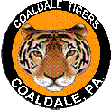Trolleys Went Everywhere In Early 1900s
EXCERPTS:
The trolley line carried passengers for the first time in October 1897 with the fare set at a nickel for a one-way trip between Lansford and Coaldale. The cost was a dime for a ride from Lansford to Tamaqua.
Fatally injured Lehigh Coal & Navigation Co. miners received free passage. The injured men who needed transportation to Coaldale State Hospital or to a doctor's office had the cost of the ride docked from their paychecks.
FULL ARTICLE:
December 10, 1999|by GEORGIE PAUFF (A free-lance story for The Morning Call)
In 1901, a gleaming, bright red trolley car left the carbarn at the corner of Chestnut and Patterson streets in Lansford. The trolley followed roughly what is Route 209 north over the crest of the mountain and sped toward Nesquehoning on newly laid tracks.
Sunlight reflected off the trolley's windows as it passed over a trestle above the site of the Room Run Mines and No. I Tunnel. It passed behind the wash shanty and followed the curvature of the mountain on "Trolley Road" into Nesquehoning.
The tracks followed what is now West High Street, turned left on Radcliff Street and proceeded north to West Catawissa Street. At the corner, the route made a 90-degree right turn and the car stopped for passengers in front of Bechtel's Hotel.
The light rail line followed East Catawissa Street but was south of Route 209, using a slightly elevated roadbed that ran between East Catawissa and East Center streets. The route continued on through what would become the Civilian Conservation Corps campground in the 1930s and now is the site of Nesquehoning Hose Company No. 1.
Just east of the intersection of routes 209 and 93, the trolley line veered south in front of the cemeteries behind Jake and Carrie Maurer's Roadhouse (The Lantern). The tracks continued east, then veered to the north to rejoin Route 209 at Dead Man's Spring.
The trolley line began as the Tamaqua and Lansford Street Railway Co. organized in 1891. The Lehigh Coal & Navigation Co. provided the financial backing; construction began in 1897.
Because electricity was already being produced by the LC&N to operate shaft elevators, mine pumps and breakers, it was relatively simple to provide power for the trolley line.
The trolley line carried passengers for the first time in October 1897 with the fare set at a nickel for a one-way trip between Lansford and Coaldale. The cost was a dime for a ride from Lansford to Tamaqua.
In 1899, service was extended to Summit Hill, providing a link to the Switchback Gravity Railroad, which ran between Summit Hill and Mauch Chunk.
The Tamaqua and Lansford Street Railway boasted a fine funeral car. Nesquehoning undertaker Joe Gallagher would have remains transported for a final one-way ride on Car No. 14 to St. Mary's, St. Cyril's or St. John's Cemetery.
Fatally injured Lehigh Coal & Navigation Co. miners received free passage. The injured men who needed transportation to Coaldale State Hospital or to a doctor's office had the cost of the ride docked from their paychecks.
Later, Car No. 14 was converted into a line repair car and used by the Mauch Chunk Transit Co.
In 1903, the trolley line was extended into Mauch Chunk and obtained operating rights over the Mauch Chunk, Lehighton and Slatington Street Railway Co.'s tracks along Susquehanna Street.
The Mauch Chunk Transit Co. operated between the three sections of the borough: East Mauch Chunk, Mauch Chunk and Upper Mauch Chunk.
Tourists arriving on the Lehigh Valley Railroad walked up the covered stairs to the intraborough bridge and boarded the trolley for Courthouse Square.
At Courthouse Square, tourists had the choice of boarding trolleys with destinations such as East Mauch Chunk; Nesquehoning, the Panther Valley, Tamaqua and Pottsville; Upper Mauch Chunk and the Switchback Gravity Railroad Station; and the Mauch Chunk line along Broadway for the Opera House, the Carbon County Jail, the swimming pool on Lentz Trail and the Flagstaff.
Following a dizzying ride to the top of Flagstaff Mountain, passengers could get off at Flagstaff to enjoy the view and the amusement park or continue on across the Mahoning Trestle into Lehighton.
In 1906, the Tamaqua and Lansford Street Railway Co., under the control of J.C. White, acquired various companies owned, controlled or operated by the Pottsville Union Traction Co. and changed its name to Eastern Pennsylvania Railways Co.
More track was laid and by Jan. 20, 1908, the line connected Tamaqua and Middleport. On Feb. 27, 1908, service between Pottsville and Mauch Chunk -- a distance of 35 miles -- was inaugurated.
However, as quickly as the trolley service spread, it was phased out just as fast because of the ever-increasing popularity of the automobile.
On Aug. 15, 1931, Eastern Pennsylvania Railways Co. abandoned service between New Philadelphia and Mauch Chunk. The Lansford to Summit Hill run lasted only a few more weeks. As the East Penn trolleys were phased out, they were replaced by buses.
The Pennsylvania Department of Highways entered the picture in 1932 and acquired Eastern Pennsylvania Railways Co.'s right of way between Nesquehoning and Mauch Chunk.
After some alterations, a highway was built along the route of the abandoned trolley line.
Georgie Pauff is a Nesquehoning author and president of the Nesquehoning Historical Society.
Source: http://articles.mcall.com/1999-12-10/news/3272687_1_trolley-line-trolley-road-trolley-s-windows



